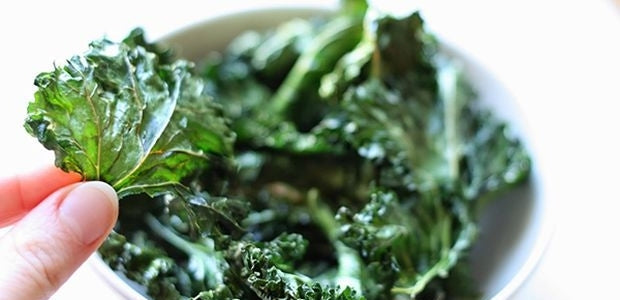Kale, or curly, fringed, laciniate, egret cabbage, you've probably heard of it; it's been all the rage in the blogosphere (and on our plates) for some time now. The reason? It's a little concentrate of vitamins and minerals, and it's very tasty! In soup, pan-fried, etc. But the best of all is potato chips.
To preserve the nutritional properties of this cabbage, it's best to heat it as little as possible. The best way to do this is to use a dehydrator, but a conventional oven at low temperature will also produce excellent results.
Ingredients
For one bowl of chips :
- 2-3 large leaves of kale leaves
- 1 small case ofolive oil (or peanut oil)
- 1 pinch of fleur de sel
Steps
- Clean leaves from kale leaves under cool running water. Pat dry with paper towel.
- Pour theoiland add pieces of cabbage leaf with a knife (discard the central stem). Mix well with your hands impregnate each leaf with oil.
- Place on a baking sheet and sprinkle with salt.
COOKING
Bake for 10 minutes at 150°C. Keep an eye on the cooking process, stirring if necessary. Leaves should be dry and crisp right out of the oven (but not burnt!).

TIPS
Be careful not to heat the oven too hot, or for too long: an unpleasant bitter taste could develop.
If your oven allows cooking below 150°C, don't hesitate to experiment with longer cooking times - you'll be preserving more vitamins and minerals!
Prepare your chips in advance: in the afternoon for an evening aperitif, for example. And they keep very well for at least 1 day, in a bowl covered with a plate.
Nutritional tip of the day ... !
Recognized as anti-inflammatory and rich in antioxidants (which bind the body's own free radicals, helping to combat cell ageing)the kale contains a lot of vitamin C (more than orange, to say the least!).. Of course, to take full advantage of this vitamin, eat your cabbage quickly and eat it raw, in a salad, with a good vinaigrette.
As with all leafy vegetables, it contains vitamin K. This cabbage isn't orange like a carrot or red like a bell pepper, but don't underestimate its vitamin K content. vitamin A !
When it comes to minerals, the amount of iron it contains is interesting (combined with the vitamin C already present, it's ideal for better absorption of this non-haem iron).. You can also count on a good dose of calcium (more than milk, on a weight-for-weight basis)..
Oh, I forgot, it contains more proteins than the average vegetable! In addition to being very low in calories and rich in fibre.
Recipe presented by:
See the whole recipe: Rose's Little Dishes



